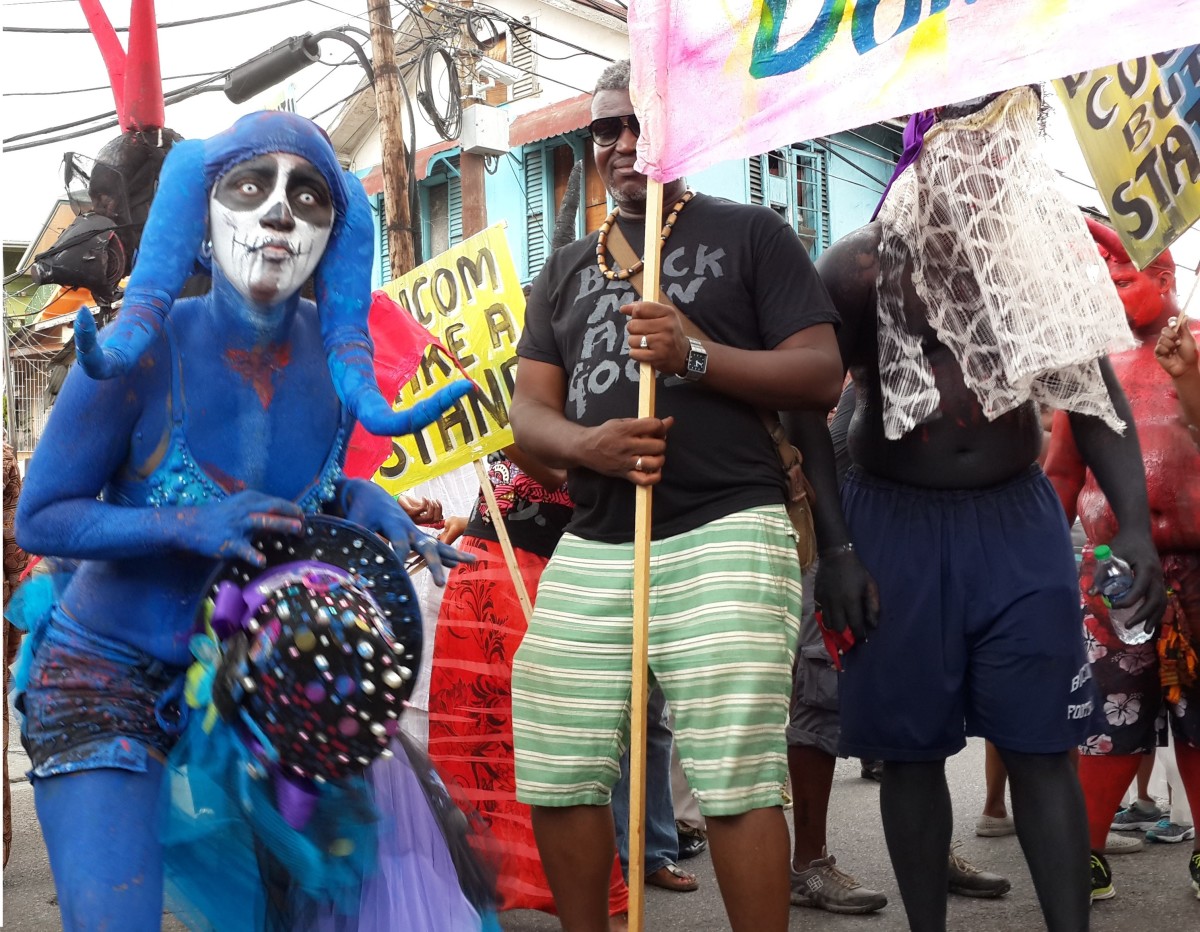When Dominican authorities commenced their most recent round of human rights violations in June this year, with the mass deportation of Dominicans who are of Haitian descent, our carnival arts collective, Jouvay Ayiti, was immediately cued to action. We came out wearing red wings, devil tails, and black body paint—an approach deeply embedded in a combination of Caribbean history and culture that speak loudly to the issues of today. Our mission is to invoke what is perceived as “badness” and to critique that claim. From Trinidad to the Dominican Republic, we use masked performance as a way to unmask truths about today’s human rights violations and their roots, particularly in Haiti and across the Caribbean.
Originally conceptualized as a creative consciousness-raising response to the rebuilding and restitution efforts in Haiti after the 2010 earthquake, the Jouvay Ayiti project has since reorganized itself as a research, and public education program that acknowledges and applies Jouvay mas (traditional masquerade), as strategy and raison d’être respectively for its ongoing work inside and outside the carnival space.

The name Jouvay Ayiti signifies various things.
Jouvay is a Kweyol expression. It’s part of a carnival nomenclature that is derived from J’ouvert (jour ouvert), which means daybreak. The expression is accurate, as Jouvay is a pre-dawn carnival ritual. But Jouvay has come to symbolize far more than that in so far as it is the moment in carnival that unconsciously and consciously retains that original Kambulay energy. Beginning (usually) at 3 AM on Carnival Monday, which is the first of two days that climaxes and closes the carnival season before Ash Wednesday, Jouvay is still home to the satirical, the topical, the ancestral, and grotesque masquerade forms, that may very well have constituted the original Kambulay bands, notwithstanding the recent noticeably increased commercial involvement.
Ayiti is the original Taino name for the land now called Haiti. It is the name Dessalines invoked in the 1805 promulgation of the constitution that overturned the government at the time, transforming the former plantation into the first state in the New World, where Black/Jab/Neg would be free.
With red wings, horns, tails, and dark body paint, we danced our disgust to the Dominican Republic Ambassador’s office, with a petition of some one thousand plus signatures collected over the course of a few days.
July wasn’t the first time we rose to action. In 2013, when the Dominican high court ruling retroactively rendered hundreds of thousands of these same persons stateless deportees, Jouvay Ayiti was the first institution from Trinidad and Tobago to have a position. With CARICOM (The Caribbean Community and Common Market) and the regional university silent, we responded with a protest precedent, in mas, or more specifically, a symbolic and historically rooted application of mas as protest, which we call mas-action.
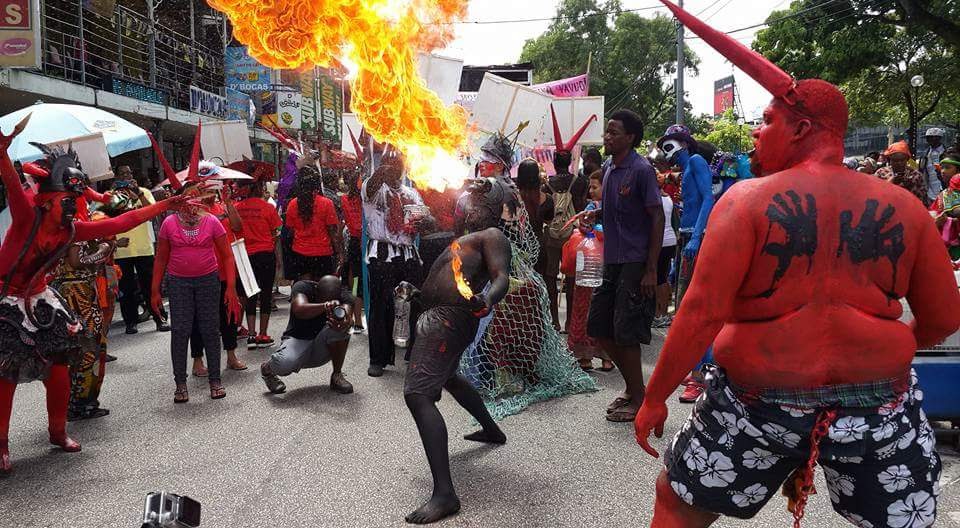
We define mas action as the use of traditional mas as a strategy for social action, consciousness raising, and popular education outside of the carnival festival period. The term mas is the Trinidad and Tobago appellation for traditional and contemporary carnival masquerade—most people will recognize this as the group dancing that takes place in Carnival masquerade processions. A mas not yet performed is referred to as a “costume.” Furthermore, a mas is not worn, it is played; in other words, the local expression for performing a mas costume is to play a mas. Mas action, therefore, is a carnival performance elevated to demand social justice.
By midday on this year’s 3rd of July, some twenty persons had gathered to participate in the mas action. What we lacked in mass, we made up for in mas. Some parents brought their children; at least five of us were no older than eleven. Some bodies were bedaubed in red (wouj), while others opted for the blackening of the body. This process of besmearing the body is critical. It originates in an older mas tradition named Jab Molassi, for molasses devil. Our cultural historians argue that in the performance of this mas, ex-enslaved Africans, would blacken their already black skins with molasses. That besmearing of the black body with a by-product of the sugar cane, which they cultivated without remuneration is essentially performance protest. Those first Jab Molassi performers, whoever they were, are easily our mas action ancestors.
The original “badness” (blackness) that Dominican Republic’s policies sought to exile from its space, are reclaimed through this street performance.
Mas performances have ancestral roots. Any if not all of the traditional mas performances bequeathed to us were once themselves reinterpretations of older traditional African masquerades. It is not by chance then that there is Jab Jab in Grenada, Neg Marron in French Guiana, and Lanse Kod in Haiti. All of these subscribe to the blackening of the black skin as mas performance, re-presenting blackness as terror and badness. Warner-Lewis, in her book Central Africa in the Caribbean, goes further in discussing the hidden transcript of this blackening thus: “Since the ascription of ‘badness’ was so intrinsically attached to the skin color black, badness was elevated into a [performance] skill as well as a threat.” To confront the atrocities of the Dominican Republic’s denationalization campaign, we opted for invocation. Indeed, to deal with this dread, some kind of “badness” had to be summoned.
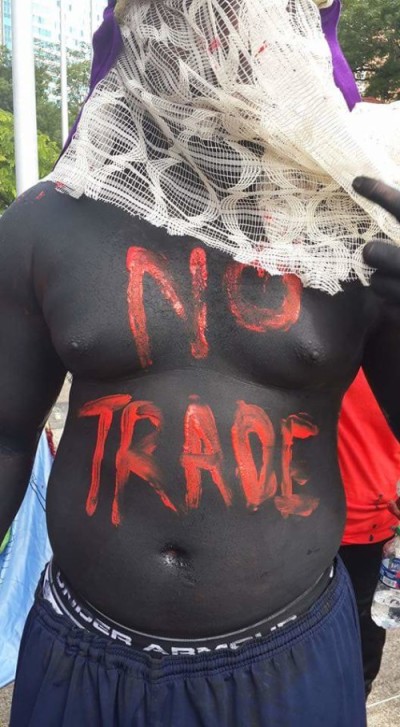
The original “badness” (blackness) that Dominican Republic’s policies sought to exile from its space, are reclaimed through this street performance. Therefore, with red wings, horns and tails (the accouterments of devil mas) and dark body paint, we danced our disgust to the Dominican Republic Ambassador’s office, with a petition of some one thousand plus signatures collected over the course of a few days. The mas was accompanied by biscuit tin percussion—the traditional music of the Blue Devil, yet another Jab form found in Trinidad—with the name of the band chanted to a St. Lucian Jab masquerade melody, completing the pan-Caribbean invocation.
Masking is a central part of this protest parade. The central ethos and organizing principle of this performance is based on “kambulay,” an expression Professor Maureen Warner Lewis claims originates from the Kikongo (Central African) term “kambula,” which means “procession.” Given the culture from which the expression emerges, it’s especially relevant that masking would form part of this parade. Kambulay is one of the key performance concepts guiding our work in both mas and mas action.
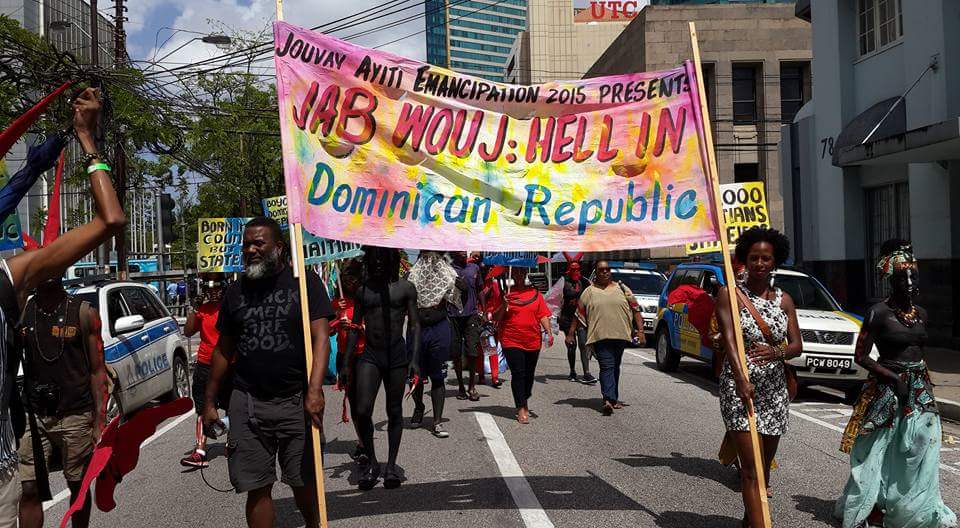
Our July 3rd mas action was thus titled Jab Wouj–Jangkanu-Wanaragua. This title attempts to be all inclusive of various Caribbean mas narratives of change.
Jab Wouj is Kweyol for “Red Devil.” We borrowed the red from the Domican Republic’s national flag to symbolize the rejection of “Blackness” that is lodged in the concept of Indio.
Jangkanu is the local (Jamaican/Caribbean) pronunciation of Jonkunu, the name given to the pantheon of traditional African masquerade in many of the Caribbean territories that were colonized by the British.
Wanaragua is the Belizean Garifuna name for the same practice. The Garifuna are also referred to as the Black Caribs–a nation birthed through the intermixing of First Nations (Carib) and African people. Originally from St. Vincent, they were exiled to Belize in late 18th century, after more than two decades of war with the British, in which they sought to defend the right to own and protect their land from British colonial invasion.
In utilizing mas signifiers from across the Caribbean, the mas consciously seeks regional involvement and inputs on any issue it chooses to engage. Jouvay Ayiti is decidedly Caribbean focused.
This nexus of narratives in the naming of the mas action is significant. In utilizing mas signifiers from across the Caribbean, the mas consciously seeks regional involvement and inputs on any issue it chooses to engage. Jouvay Ayiti is decidedly Caribbean focused.
So potent were the social media responses for our July 3rd action that a collective from Toronto opted to lend their voices to the discussion. Calling themselves Jouvay Ayiti, the Toronto Chapter, the group chose to present a mas action on August 1st, Emancipation Day. For the Toronto contingent, presenting the mas on Emancipation morning was a jouvay to the CARIBANA, Caribbean Carnival celebrations in Canada. For us in Trinidad, it was also a jouvay. Here was Jouvay Ayiti re-positioning the mas, the Kambulay energy in its original space; inside the festival now commemorated by dancing in procession while dressed in African wear.
On Emancipation morning we took to the streets, almost double the number we were on July 3rd, but dancing among thousands. We could see the questions in the eyes of the masses. But the placards (which are consistent with yet another style of traditional mas called Ol’ Mas, as opposed to simply protest), and the accompanying performance, quieted their concern. They could see our protest was integrated with celebration.
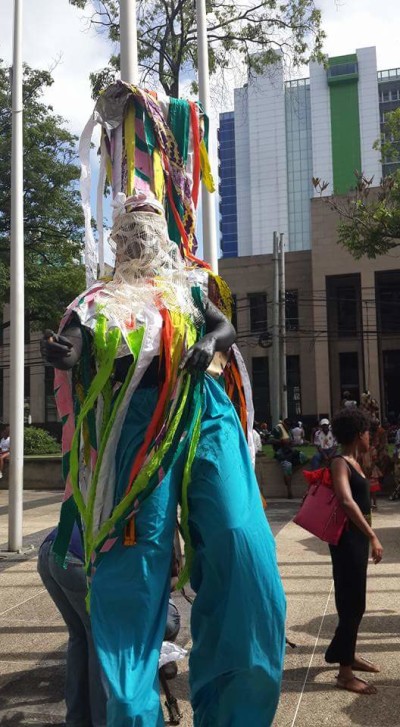
A young male dancer stripped to his boxers before blackening himself. In red, he wrote on his back “HAITI[AN] LIVES MATTER”, reinterpreting the hashtag popularized through protests against injustices meted out to persons of African heritage in the United States, to a mas for Dominicans of Haitian heritage in Port of Spain. His female colleague followed suit; her loins wrapped in African print, her half naked back declaring in wouj, “I CRY FOR HAITI… STAND.” Another masquerader wrote on his chest, “NO TRADE.” The Jabmolassi principle of making the body a canvas was clearly at work. One female reveler who opted for red, danced with a snake she made form discarded materials, as if summoning Damballah, the Vodou Loa of creation to join our mas outcry.
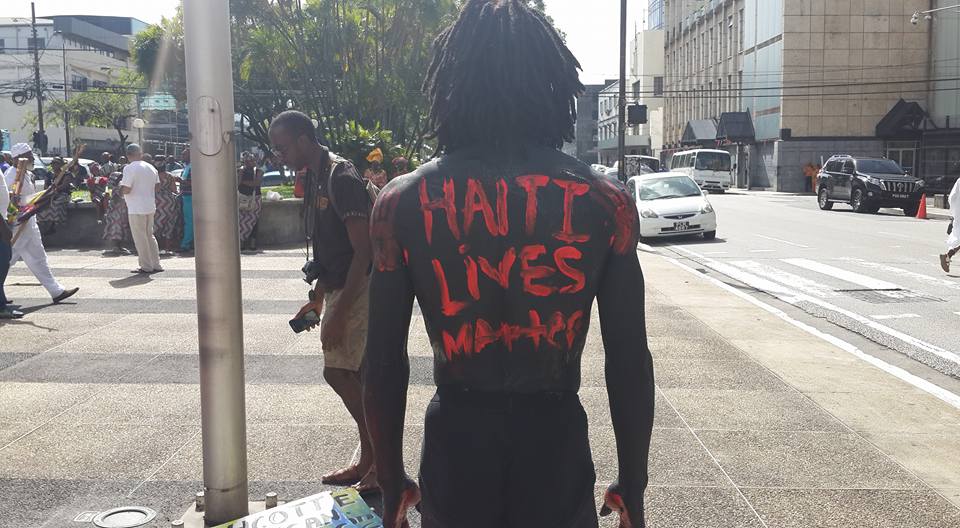
A seasoned Blue Devil mas performer appeared on the road in costume. She and her partner wore blue. Together they looked like Baron Samedi and Maman Brigitte. In traditional masquerade, when the performer wears the mask, it is accepted that the deity is present. It evoked the question: Could it be that these Gods came to dance in solidarity with us? Meanwhile a fire-blowing devil cleared the road and drew attention to us with that fire, as a Moko-Jumbie (local mas name for stilt-walker) danced a placard marked “BOYCOTT [THE] DOMINICAN REPUBLIC,” amplifying our position–her own position a towering statement in our performance.
All of these statements were created by the performers themselves. Part of the Jouvay Ayiti ethos is to make mas through the offer of a title/theme, a concept, and creative support in the form of workshops. We don’t sell costumes, as is the case with commercial carnival bands. In this case, the masquerader qua designer has full agency in the creative protest process.
For Carnival 2016, we continue to tackle the issue of reparations with a Jouvay mas titled “DJAB SE YO NEG–PAY DE DEVIL.”
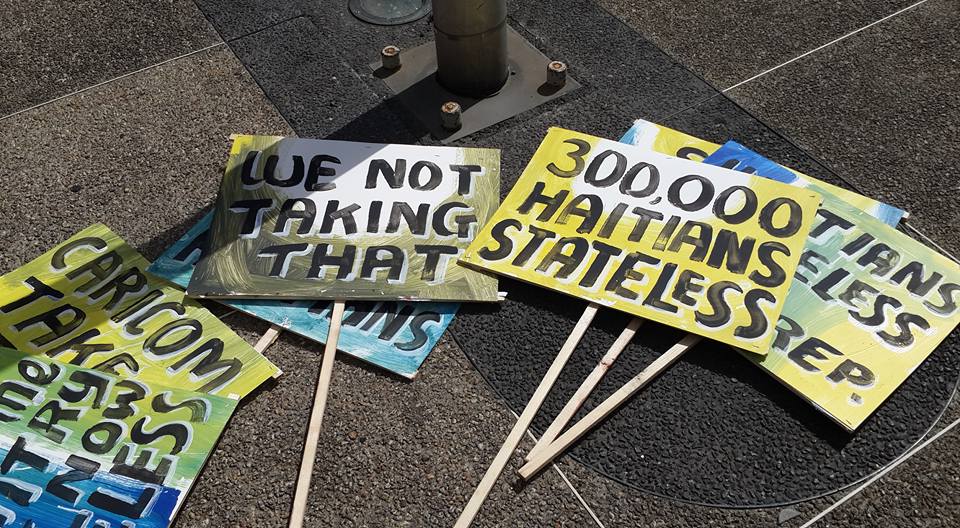
We are putting a call out to people around the world who are interested in being a part of our 2016 reparations mas camp-us. The focus will be on training in traditional mas-crafts, public lectures on traditional mas and reparations, field trips, and of course Jouvay on the road, where we make our statement inside carnival. The issues in the Dominican Republic, if unresolved, will surely be in for our street fire again. History demands it.
